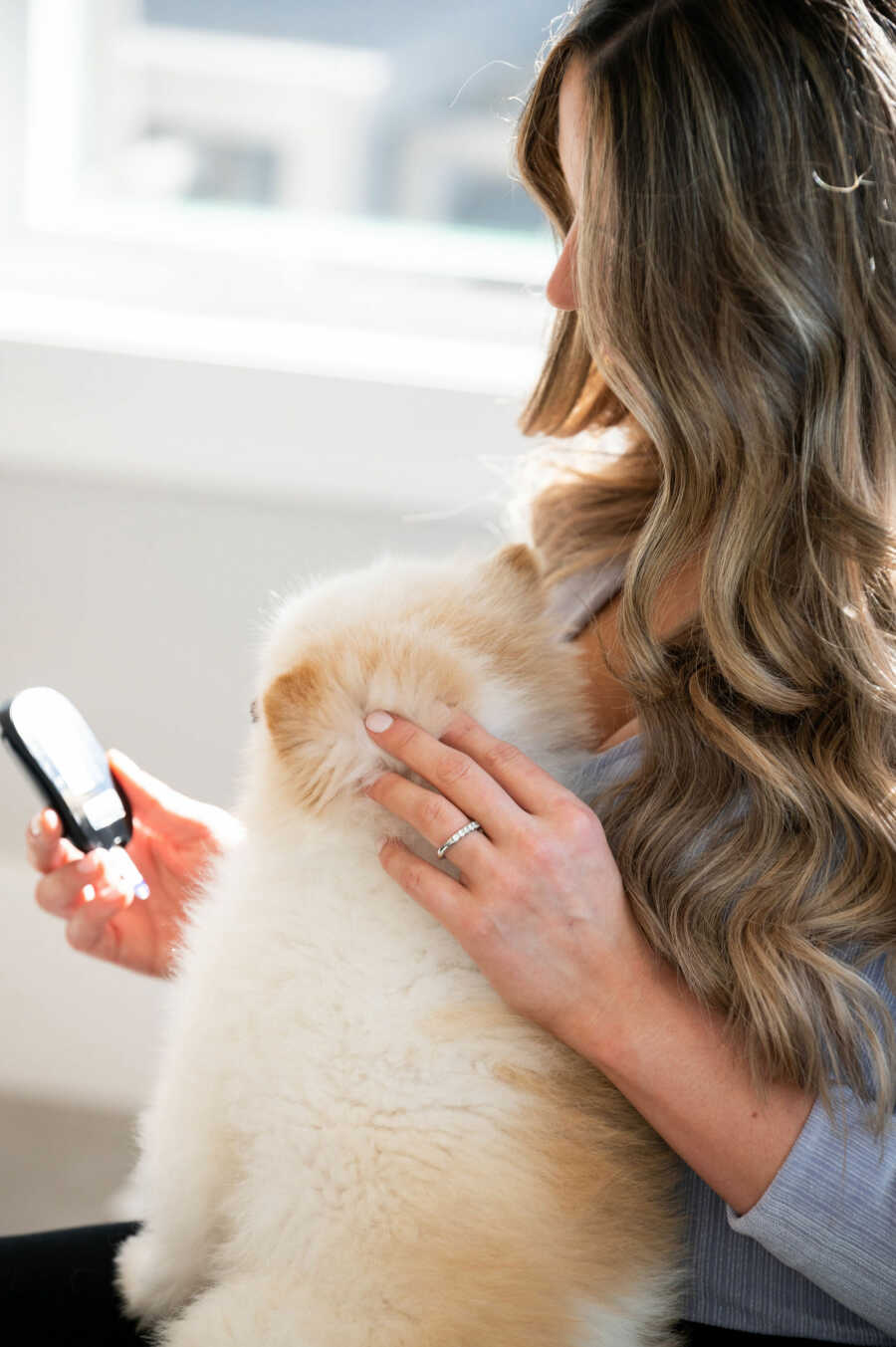“As a Type 1 Diabetic, my pregnancy was considered high risk. Throughout each trimester, my blood sugars dramatically wavered due to fluctuating hormone levels. Although I had been administering daily insulin shots for the past 13 years, my body’s response to them had become unpredictable.
It’s not uncommon in your first few months of pregnancy to experience frequent low blood sugars. I was instructed to aim for blood sugar levels within a very narrow target range. Given the small margin for error, I constantly found myself afraid to eat because I couldn’t figure out how much insulin to give myself with every meal. Even without eating, my blood sugar would spike or drop depending on my level of physical activity, stress, and hormones.

During this memorable hypoglycemic episode, I asked the clerk to hold my bags and gestured to my belly to indicate I was pregnant and needed to sit down. I was too out of it (and quite frankly, embarrassed) to even explain that I was a Type 1 Diabetic. I sat between the set of automatic sliding doors on my winter coat and wiped the sweat off my forehead as I shakily finished the bottle of Coke. Looking back, it was odd that nobody checked to make sure I was okay. But at that moment, I was relieved to be spared the uncomfortable interaction as I eventually made it back onto my feet.
As frustrating as the situation seemed, I was fortunate to be benefitting from some recent technological advances that empowered me to optimize my blood sugars. Having a Continuous Glucose Monitor (CGM) allowed me to track my blood sugar readings on my phone 24/7 in real-time. This constant awareness of my sugars caused as much anxiety as it did assurance. When my glucose levels were outside of my target, my monitor would beep and buzz at all hours of the day and night. Under the direction of the high-risk obstetrics team, I also kept a manual journal of my sugars and insulin dosages, which they reviewed weekly. During this time in my life, I checked my sugar level, took insulin, checked my sugar level, repeat.

On top of the bi-weekly clinic check-ins, I had monthly ultrasounds and eventually went in to have non-stress tests (NSTs) twice a week. The non-stress test was the opposite of how it sounds: very stressful. During the tests, a cluster of monitors was placed on my belly to assess the baby’s heart rate and responsiveness. On one of the last NSTs before delivery, the doctor came into the room to unhook me from the monitors. This usually meant the test was over and I could return home…but this time was different. I was instructed to leave the outpatient clinic and head directly to the main hospital.
The baby’s activity level was below normal, so further testing was required. Just before leaving, the doctor informed me there was a chance I’d be admitted for delivery. In a panic, I drove myself to the hospital and found the triage area on the labor and delivery floor. I was met by a team of nurses and doctors who were already briefed on the situation and ready to apply a new set of monitors. Although everyone reassured me that this trip to the hospital was precautionary, I became increasingly concerned as each hour passed by. I nervously took bites out of a protein bar to maintain my sugar levels while frantically texting my husband. Finally, after three hours of assessments, the baby’s activity level and heart rate normalized; there was no need for intervention, and I was able to go home.

A week later, during my follow-up visit with the high-risk OB clinic, I got the news that although my blood sugars were well controlled, things could change quickly, and all diabetics need to be induced no later than week 39 of gestation. Suddenly, my carefully drafted birth plan was in disarray as I was scheduled for induction in less than a week.
That following Tuesday, I was back on the Labor and Delivery floor being induced. I was in labor for three days and had so many wires, tubes, and devices hanging off me, I felt like a marionette. Although my family wasn’t allowed to come to the hospital due to COVID protocols, I called them with Facetime endlessly over those few days, which kept my spirits up. Memorably, one of my video chats with my niece and nephews resulted in me laughing so hard that my water spontaneously broke while we were waiting for the doctor to rupture it manually.
Although my water breaking was a welcomed development, I wasn’t progressing fast enough. I spiked a fever, and the doctors became eager to get my daughter delivered ASAP. At 10 a.m., I was told that if I wasn’t fully dilated in the next hour, I would be taken into the OR for an emergency cesarean section. When the doctors returned for my hourly evaluation, I began to feel a deep pressure. They checked and I was fully dilated, narrowly missing the threat of surgery.
At lucky 11:11 a.m., my daughter Monroe was placed on my chest after only 10 minutes of pushing. I was gradually released from the heap of monitors and IVs and a mental weight was lifted. All of the anxiety, stress, and emotions of the pregnancy led to this blissful moment as I cradled her singing the ABCs.
It was all worth it, and it prepared me for the pregnancy of my son, Miles, a short 15 months later.

One day, I know I will talk to my children about how they came into this world, and how hard I fought for them to be healthy while inside my womb. From a mom who knows firsthand how challenging it can be to explain Type 1 Diabetes, here are some tips for starting the conversation with your kids or loved ones:
1. Explain diabetes in simple, but uplifting terms. That it’s a manageable condition and those with diabetes can lead long, healthy, and happy lives by making good choices.
2. Emphasize that when someone has type 1 diabetes, it’s not their fault and they didn’t cause it in any way. Type 1 diabetes is an autoimmune disease that prevents the body from creating insulin. It isn’t caused by poor diet or lack of physical activity.
3. Openly educate and inspire ways to develop a healthy relationship with food and exercise. Make it a fun routine in which the whole family participates. After all, everyone needs to make healthy choices, not just diabetics.
4. Reassure them that finger pricks and injections might seem intimidating, but they come with many benefits and aren’t scary.
5. Instill confidence that the condition isn’t something that needs to be hidden. There is a large community of diabetics along with celebrities and influencers, like Nick Jonas, Robin Arzón, and Jay Cutler, who speak openly about Type 1 Diabetes.”

This story was submitted to Love What Matters by Vanessa Messenger. You can follow her journey on Instagram, TikTok, Facebook, and her website. Submit your own story here, and be sure to subscribe to our free email newsletter for our best stories, and YouTube for our best videos.
Read more about diabetes warriors here:
Provide beauty and strength for others. SHARE this story on Facebook with your friends and family.

